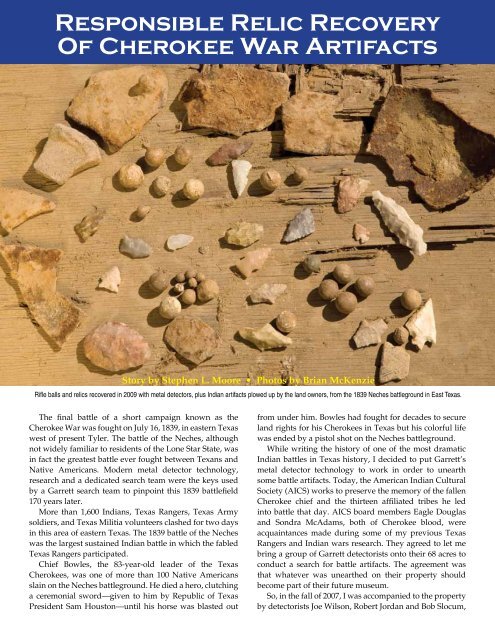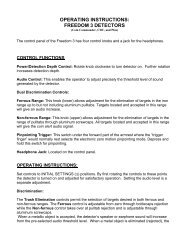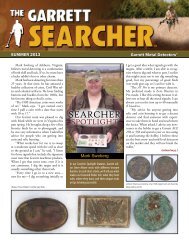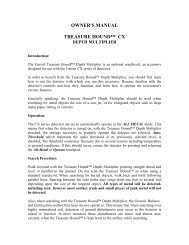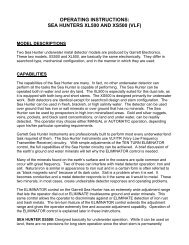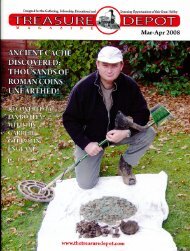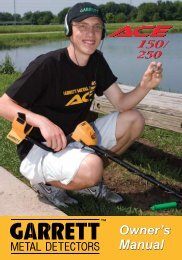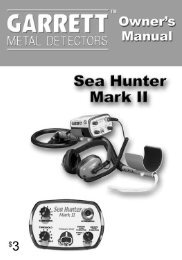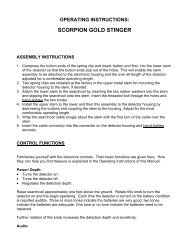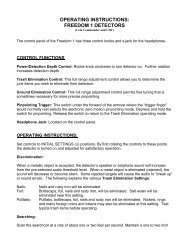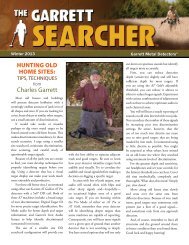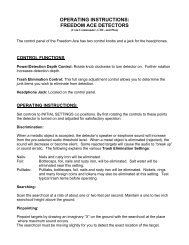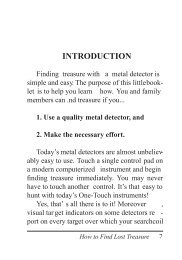Responsible Relic Recovery Of Cherokee War Artifacts - Garrett
Responsible Relic Recovery Of Cherokee War Artifacts - Garrett
Responsible Relic Recovery Of Cherokee War Artifacts - Garrett
Create successful ePaper yourself
Turn your PDF publications into a flip-book with our unique Google optimized e-Paper software.
<strong>Responsible</strong> <strong>Relic</strong> <strong>Recovery</strong><br />
<strong>Of</strong> <strong>Cherokee</strong> <strong>War</strong> <strong>Artifacts</strong><br />
Story by Stephen L. Moore • Photos by Brian McKenzie<br />
Rifle balls and relics recovered in 2009 with metal detectors, plus Indian artifacts plowed up by the land owners, from the 1839 Neches battleground in East Texas.<br />
The final battle of a short campaign known as the<br />
<strong>Cherokee</strong> <strong>War</strong> was fought on July 16, 1839, in eastern Texas<br />
west of present Tyler. The battle of the Neches, although<br />
not widely familiar to residents of the Lone Star State, was<br />
in fact the greatest battle ever fought between Texans and<br />
Native Americans. Modern metal detector technology,<br />
research and a dedicated search team were the keys used<br />
by a <strong>Garrett</strong> search team to pinpoint this 1839 battlefield<br />
170 years later.<br />
More than 1,600 Indians, Texas Rangers, Texas Army<br />
soldiers, and Texas Militia volunteers clashed for two days<br />
in this area of eastern Texas. The 1839 battle of the Neches<br />
was the largest sustained Indian battle in which the fabled<br />
Texas Rangers participated.<br />
Chief Bowles, the 83-year-old leader of the Texas<br />
<strong>Cherokee</strong>s, was one of more than 100 Native Americans<br />
slain on the Neches battleground. He died a hero, clutching<br />
a ceremonial sword—given to him by Republic of Texas<br />
President Sam Houston—until his horse was blasted out<br />
from under him. Bowles had fought for decades to secure<br />
land rights for his <strong>Cherokee</strong>s in Texas but his colorful life<br />
was ended by a pistol shot on the Neches battleground.<br />
While writing the history of one of the most dramatic<br />
Indian battles in Texas history, I decided to put <strong>Garrett</strong>’s<br />
metal detector technology to work in order to unearth<br />
some battle artifacts. Today, the American Indian Cultural<br />
Society (AICS) works to preserve the memory of the fallen<br />
<strong>Cherokee</strong> chief and the thirteen affiliated tribes he led<br />
into battle that day. AICS board members Eagle Douglas<br />
and Sondra McAdams, both of <strong>Cherokee</strong> blood, were<br />
acquaintances made during some of my previous Texas<br />
Rangers and Indian wars research. They agreed to let me<br />
bring a group of <strong>Garrett</strong> detectorists onto their 68 acres to<br />
conduct a search for battle artifacts. The agreement was<br />
that whatever was unearthed on their property should<br />
become part of their future museum.<br />
So, in the fall of 2007, I was accompanied to the property<br />
by detectorists Joe Wilson, Robert Jordan and Bob Slocum,<br />
Story by Stephen L. Moore • Photos by Brian McKenzie
plus Vaughan <strong>Garrett</strong> and Brian McKenzie to document any<br />
discoveries with video and still photography. We brought<br />
along a number of <strong>Garrett</strong>’s most advanced metal detectors:<br />
the GTI 2500, GTI 1500, GTP 1350 and an ACE 250. We worked<br />
into the late afternoon, doing reconnaissance scanning of<br />
the areas surrounding a field containing Bowles’ marker.<br />
We also ventured into the deep woods, working through<br />
deep creek beds and following them out toward the Neches<br />
River bottomlands. By the end of a full day’s hunt, we had<br />
collected shotgun shells, modern bullets and various rural<br />
farmland metallic junk. Joe even dug up some World <strong>War</strong><br />
I-era blunts, bullets somewhat similar to those used decades<br />
before during the Civil <strong>War</strong>.<br />
The artifacts we sought from the 1830s period had proven<br />
to be elusive. Several weeks later, I returned to search the<br />
AICS property again with Joe, Robert and Keith Wills. We<br />
searched over some of the likely areas near the creek and<br />
all around the large hilltop where a Delaware Indian village<br />
was said to have been. Once again, we found modern bullets,<br />
some coins, an old watch and miscellaneous metallic junk.<br />
The four of us then made a reconnaissance line and scouted<br />
with our detectors back toward the road, moving up another<br />
small hill and into the forest again before finally reaching the<br />
property’s barbed wire fence line.<br />
Keith and I agreed that we must be searching on the tail<br />
end of the battlefield. Obviously, there were some artifacts in<br />
this area at one time but even modern souvenir hunters and<br />
previous timber-cutting operations would not have removed<br />
all traces of such a heavily-contested battle. The next step<br />
was to research the earliest information on the Neches<br />
battle more thoroughly while attempting to gain permission<br />
from the adjacent landowners to conduct a survey on their<br />
property.<br />
(Left) In his "Battle of the Neches"<br />
painting from 1967, artist Donald M.<br />
Yena captured the closing moments of<br />
the 1839 battle. Chief Bowles (below),<br />
with his ceremonial sword upraised,<br />
is shot in the back after his horse has<br />
been crippled with numerous rifle ball<br />
shots. Painting used by permission of<br />
Frank Horlock and Michael Krueger.<br />
Bowles illustration courtesy of Texas<br />
State Library & Archives Commission.<br />
Since our first efforts to recover relics on the AICS land<br />
had been fruitless, I decided to forget about where the<br />
Bowles marker stands and where the battle was assumed<br />
to have been concentrated. It was time to dig back into the<br />
earliest accounts of the battle and to visit with others who<br />
might have some useful information.<br />
A 1920s article by Dr. Albert Woldert became my<br />
primary focus, particularly several detailed maps based on<br />
his research. The spot where he had labeled Chief Bowles<br />
to have died was on the opposite side of a particular<br />
creek than where I had expected it to be shown. Modern<br />
graphics programs allowed me to scan in this map and<br />
overlay it on a satellite image of the area and on a scanned<br />
page from a detailed Texas road map of the county. The<br />
new composited picture convinced me that we would<br />
find the main battle area somewhat south of the area<br />
owned by AICS. This map work convinced me that the<br />
old Delaware village was not exactly on the hilltop where<br />
the tribal stones have been placed. Could there be another<br />
significant hilltop within 300 yards to the southwest?<br />
Fortunately, landowners Thurman and Alice Jett<br />
were open to this historical quest and it was with great<br />
excitement that I led another group of detectorists to hunt<br />
their land in early 2009. Mr. Jett even mentioned that his<br />
family had plowed up bits of old pottery for years and<br />
had often found arrowheads on their property. It was all<br />
coming together like lost pieces to a puzzle. As our <strong>Garrett</strong><br />
search team first drove onto the property to meet the Jetts,<br />
there was the hill I had hoped to find! It rose up out of the<br />
heavy timber from the south, reached its peak right where<br />
the home sits and then fell off sharply on the north and<br />
east sides. Behind the Jett’s home is a steep hill that opens<br />
onto a vast farmland prairie containing a small creek.
The location we had reached on the Jett property had<br />
all of the necessary elements to make Woldert’s notes<br />
fit. We just needed to find evidence that would prove it<br />
beyond a doubt. For this recon mission, my companions<br />
were Joe Wilson, his uncle Stan May, Robert Jordan and<br />
Brian McKenzie, the latter doubling as both the excursion’s<br />
photographer and detectorist. We fanned out and began<br />
searching the vast prairie behind the Jett home, working<br />
our way along a small spring-fed pond back toward the<br />
Neches River bottomlands. Most of our efforts throughout<br />
the day were on the open prairie, in the heavy woods to the<br />
north of the field or in the bottomlands. As on the adjoining<br />
68 acres of AICS lands, we dug some metal junk and plenty<br />
of modern projectiles of all calibers.<br />
It was such a vast area of land for five detectors to cover<br />
that it was mid-afternoon before we finally tasted success.<br />
Robert Jordan, using a GTP 1350, had a solid hit in the<br />
forest that read as a 7 on his Target ID scale. With the aid<br />
of his trusty Pro-Pointer, he retrieved a genuine nineteenthcentury<br />
lead musket ball from a depth of four inches.<br />
This proved to be our only definite relic from the<br />
Neches battle this day but it was enough to encourage me<br />
to begin thinking about a return. Dr. Gregg Dimmick, who<br />
has long used metal detectors in his archaeological research<br />
on the Mexican Army’s retreat after the 1836 battle of San<br />
Jacinto, encouraged me to send the size, weight and photos<br />
of this musket ball to Doug Scott. Doug is a ballistics expert<br />
famous for his work on artifacts from the Little Bighorn<br />
battle. He quickly confirmed that it was a standard .69<br />
caliber ball which certainly would have been used in the<br />
1830s.<br />
Our search team returned to the Jett farm in March<br />
2009, with their permission to conduct another hunt. For<br />
this foray, we recruited additional volunteers from the<br />
Lone Star Treasure Hunting Club of Dallas. In addition to<br />
Robert, myself, Brian McKenzie, Joe Wilson, and Stan May,<br />
seven others were on hand to put their skills to the test:<br />
Paul Wilson, Mike Skinner, Rusty Curry, Bob Bruce, Matt<br />
Bruce, Robert Jeffrey, and Dave Totzke.<br />
Shortly after 11:00 a.m., Paul was the first to find a<br />
.69-caliber musket ball with his GTI 1500. Within minutes,<br />
Paul recovered another ball and Bob Bruce soon followed<br />
suit. By the time I emerged from a deep thicket, I found<br />
that Bob, Paul, Matt Bruce, Robert Jordan and Dave Totzke<br />
had each recovered 1830s musket balls. Before I could<br />
reach the middle of the field, Dave announced, “I’ve got<br />
another one!”<br />
He was curiously spinning a small metal orb in his<br />
fingers. “This must be from a pistol,” he mused. “It’s<br />
much smaller than the musket balls we’re finding.”<br />
Dave made another probe of his excavation area with his<br />
Pro-Pointer. It suddenly rattled and hummed with the<br />
distinctive announcement of another metallic target. What<br />
he recovered was even more exciting–three more smaller<br />
balls, each about twice the size of a child’s BB.<br />
“Do you know what this is?” he asked. “It’s a buck and<br />
ball load!”<br />
The pinpointer had enabled Dave to find the much<br />
smaller buckshot which he most likely would have missed.<br />
Such small targets easily blend in with the dirt. The prior<br />
First find! Robert Jordan holds<br />
the first .69-caliber lead rifle ball<br />
(seen above) found by the <strong>Garrett</strong><br />
search team on the property<br />
where <strong>Cherokee</strong> Indians and<br />
the Texas Rangers fought their<br />
greatest battle.<br />
Neches battleground search<br />
team on March 4, 2009. (Left<br />
to right, standing): Stan May,<br />
Mike Skinner, Paul Wilson, Dave<br />
Totzke, Robert Jeffrey, Robert<br />
Jordan, Steve Moore, Rusty<br />
Curry and Joe Wilson. (Kneeling,<br />
left to right): Matt Bruce and<br />
Bob Bruce.
(Left) This three-piece buck<br />
and ball load was recovered<br />
by Dave Totzke. The smaller<br />
buckshot balls measure .32<br />
inches in diameter.<br />
(Below) The author recovers<br />
a flattened .69 caliber rifle or<br />
musket ball.<br />
recovery of a nice, albeit smaller, musket ball might have<br />
satisfied a novice searcher that he or she had found the metal<br />
detector’s announced target. Before the day was out, Dave<br />
would find another similar buck and ball load with the aid<br />
of his Pro-Pointer.<br />
I have read Charles <strong>Garrett</strong>’s words and have heard him<br />
utter the phrase many times: “You can find treasure even<br />
in your own backyard!” In this case, we had found historic<br />
relics right in the Jetts’ own front yard!<br />
These musket balls and buck and ball loads were likely<br />
dropped by Texans who were firing at Indians in the creek<br />
bed below them. Some of the discovered shots had perhaps<br />
been fired back up at the Texans by the <strong>Cherokee</strong>s. Our<br />
team continued working the field during the next hour and<br />
most recovered at least a couple of musket balls. In addition,<br />
Dave, Paul, Joe Wilson, Robert Jordan, Rusty Curry and<br />
Mike Skinner each managed to recover pieces of an old iron<br />
cooking pot that appear to have been shattered many years<br />
ago by someone plowing the land.<br />
Following a quick lunch break, I struck out across the<br />
top of the hill in front of the Jett home toward the area where<br />
Robert had found the lone rifle ball weeks before. I topped<br />
the little prairie’s highest elevation and had just started<br />
down the back slope when my GTI 2500 sang out with a<br />
solid hit. It was right on the 7 mark on the scale, just where<br />
the other balls had been registering.<br />
Using my spade, I popped a six-inch-deep plug and<br />
began probing the recovery hole with my Pro-Pointer. In<br />
short order, it began vibrating and audibly rattling with the<br />
sweet sound of a solid target. From the soft soil, I retrieved<br />
a somewhat flattened hard piece of lead that was solid and<br />
heavy. Brushing it off, I quickly realized it to be a musket ball<br />
that had mushroomed on impact. It was a sobering thought<br />
These battlefield relics were dug on the main July 16 battle site. (Left to right) A<br />
1.1 oz. .69 caliber musket ball that has flattened upon impact; an intact .69 caliber<br />
musket ball which was likely never fired (notice the tip of the sprue that was not<br />
properly clipped off); a .42 caliber ball which also dropped (which appears to have<br />
not been trimmed after molding); and a properly formed .69 caliber musket ball.<br />
indeed to realize that this little pancaked treasure had likely<br />
ended someone’s life in 1839.<br />
Paul Wilson and Robert Jeffrey each soon discovered<br />
similarly flattened rifle balls while Stan found another intact<br />
ball that had obviously missed its mark. This area would<br />
prove to be the initial skirmish line where Texan scouts had<br />
been taken under fire by the <strong>Cherokee</strong>s in July 1839. A few of<br />
our recoveries were buck and ball loads in which the larger<br />
ball still possessed its little “nub” or the tab that might have<br />
been snipped off prior to packing a load.<br />
Gregg Dimmick, ballistics expert Doug Scott and Byron<br />
Johnson, Executive Director of the Texas Ranger Hall of<br />
Fame and Museum in Waco, all helped confirm that the<br />
.69-caliber and other smaller balls we had found were<br />
certainly available in 1839. With the help of Donaly Brice of<br />
the Texas State Archives, I later tracked down a July 1839<br />
document confirming that the Texas Rangers had indeed<br />
been supplied with 50 pounds of buckshot prior to the battle<br />
to use in buck and ball loads. Chief Bowles, in fact, is known<br />
to have been shot in the back by a buck and ball shot.<br />
The Jett family was kind enough to let us make an<br />
additional search of their land on April 1, and we were again<br />
able to further define the battle areas. My team this day<br />
included detectorists Mike Skinner, Robert Jordan, Richey<br />
Davidson, Brenda Davidson, Ray Wathar and Ronnie Morris,<br />
plus Vaughan <strong>Garrett</strong> and Brian McKenzie to document the<br />
recoveries with video and photos.<br />
Our search efforts were concentrated in the lower fields<br />
this day below the upper hill where many of the relics had<br />
been previously unearthed. A number of additional rifle<br />
balls were discovered within 30 yards of the twisting creek<br />
where the <strong>Cherokee</strong>s had been positioned during the Neches<br />
battle. Most of the lead balls this day were of the .69 caliber<br />
size and a few stray shots were even found on the far side of<br />
the creek, away from the main battle area.<br />
From the two concentrated areas of relic recoveries<br />
previously encountered and this hot spot near the creek,<br />
we could pretty clearly visualize the 1839 Neches battle.<br />
The terrain, the slope and the creek bed below the hill fit the<br />
various descriptions of the battlefield that were penned in<br />
1839 by some of the Texans. Beyond the creek bed, a heavy
(Above) These helping hands who helped hand back history are seen here displaying the musket balls,<br />
buckshot and bullet button found on the Neches battlefield.<br />
thicket eventually opens into the small clearing where the<br />
Chief Bowles monument now stands. We had discovered<br />
rifle balls all the way up to the edge of Mr. Jett’s property<br />
leading generally from the most heated area toward the<br />
Bowles marker—which was located perhaps 200 yards<br />
beyond this area of the creek through heavy forest.<br />
Our metal detectors had helped solve the mystery of<br />
where Bowles’ <strong>Cherokee</strong>s had made their last stand 170<br />
years ago. My thoughts now turned to preserving these relics<br />
so that future generations can benefit from the knowledge<br />
of this history that we had unearthed. From the start, I had<br />
promised Eagle Douglas and his American Indian Cultural<br />
Society that I would donate significant artifacts to his group<br />
to help promote their efforts. The Jett family kindly donated<br />
arrowheads and Native American pottery found on the<br />
battlefield for the donation cases.<br />
(Left) Ray Wathar digs into<br />
a weed patch to unearth another<br />
rifle ball near the creek.<br />
(Right) Detail photo of a<br />
.69-caliber ball and a 19th<br />
century bullet button found<br />
on the battlefield.<br />
This article is condensed from <strong>Garrett</strong> detectorist<br />
Stephen L. Moore’s new book called Last Stand of the<br />
Texas <strong>Cherokee</strong>s. In addition to an extended version<br />
of the relic recovery, Last Stand covers the life of Chief<br />
Bowles, his tribe’s land struggles and the subsequent<br />
frontier battles of the <strong>Cherokee</strong> <strong>War</strong>.<br />
In addition, it became clear to me that it would be<br />
proper to offer historical relics to both sides. The Texas<br />
Ranger Museum and Hall of Fame in Waco seemed like the<br />
natural fit, as six companies of early Rangers fought in this<br />
East Texas conflict. Both the Texas Rangers Museum and the<br />
AICS board members were thrilled to receive donation cases<br />
of our recovered relics. We know that these two groups will<br />
share the knowledge of these relics with any who possess an<br />
interest in this history.<br />
Many decades have passed since that last stand of the<br />
Texas <strong>Cherokee</strong>s and their affiliated tribes. Thanks to the<br />
sophisticated electronic circuitry of some modern metal<br />
detectors, we were able to brush aside the legends and<br />
precisely pinpoint the spot where Republic of Texas-era<br />
colonists had forever dimmed the light of hope held by the<br />
<strong>Cherokee</strong>s to peacefully settle on Texas soil.
Neches battleground scenes. (Clockwise from above.) Vaughan <strong>Garrett</strong> captures the look of<br />
genuine excitement as Robert Jordan finds a musket ball. Matt Bruce holds up another ball<br />
found with his ACE 250 in the upper field. The state of Texas erected this Centennial Marker<br />
in 1936 to mark the spot where Chief Bowles died in battle. Another of the <strong>Garrett</strong> search<br />
groups (l-r): Richey Davidson, Ronnie Morris, Brenda Davidson, Ray Wathar, Mike Skinner<br />
and Steve Moore.<br />
(Left to right): Author presents an artifact case to Texas Ranger officers Lieut. George Turner<br />
of Company F, Capt. Al Alexis of Company B, and Capt. Kirby Dendy of Company F, Waco.


